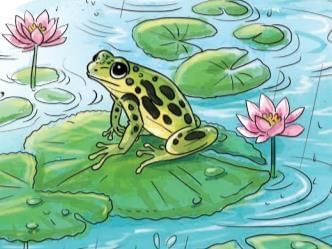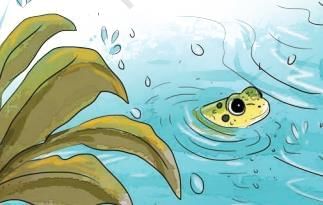Detailed Summary: The Frog | English Santoor Class 5 - New NCERT PDF Download
| Table of contents |

|
| Key Points of the Poem |

|
| Detailed Summary |

|
| Theme / Message |

|
| Difficult Words |

|
Key Points of the Poem
- Frogs live in ponds, rain, and muddy places.
- They start life as tadpoles and swim happily.
- Frogs catch food quickly with their tongues.
- They can live on both land and water.
- Their colors help them hide in grass and leaves.
- They must be careful of snakes.
- Frogs croak loudly in the pond.
- They hop high and swim easily with webbed feet.

Detailed Summary
First Stanza
I sit in ponds and in the rain,
Or hop about in a muddy drain.
The frog lives in ponds, enjoys the rain, and hops around in muddy drains. It loves wet places and doesn’t mind getting dirty. This shows that frogs are happy in water and enjoy moving around freely.
Second Stanza
As a tadpole, I swim with cheer,
A tiny fish-like thing, so clear!
I flick my tongue to catch my food,
It works so fast—now that’s quite good!
The poet talks about the creature when it was a baby, called a tadpole. Tadpoles look like tiny fish and swim happily in the water. As it grows, the creature uses its quick tongue to catch food. This shows how it changes as it grows and learns to take care of itself.
Third Stanza
I live on land and water too,
In places damp with drops of dew.
My colours match the plants and trees,
I hide so well in grass and leaves!
Frogs can live on land as well as in water. They like damp places where there is dew. Their colors help them hide in grass and leaves, keeping them safe from enemies. This shows how frogs use nature to protect themselves.
Fourth Stanza
But snakes are near, I must beware,
Or else they’ll catch me unaware!
I croak my songs, they sound so loud,
Yet in my pond, I feel so proud.
Frogs must be careful of snakes, which can harm them. Even though there is danger, frogs croak loudly and feel proud in their pond. This shows that frogs are brave and happy in their homes.

Fifth Stanza
I hop around, I jump so high,
Up I go into the sky!
With webbed feet, I swim with ease,
And leap so high in joyful breeze!
Frogs hop and jump high, almost as if flying. Their webbed feet help them swim easily. This shows that frogs are full of energy, enjoy life, and move freely in their surroundings.
Theme / Message
Theme: The poem highlights the life of a frog, its habits, and its connection with nature, showing how it lives in water and on land, moves, feeds, and communicates.
Message: Frogs are adaptable creatures that survive by being alert to dangers like snakes, using their natural skills like hopping, swimming and they enjoy life in their environment, showing the beauty of simple, joyful living in nature.
Difficult Words
- Pond - A small body of still water.
- Drain - A pipe that carries off water.
- Tadpole - A young frog that lives in water and has a tail.
- Flick - To move quickly and lightly..
- Beware - To be cautious of something dangerous.
- Croak - The sound made by a frog..
- Webbed - Having skin between the toes for swimming.
- Breeze - A gentle wind.
- Dew - Tiny drops of water that form on surfaces in the morning or evening.
|
44 videos|451 docs|63 tests
|
FAQs on Detailed Summary: The Frog - English Santoor Class 5 - New NCERT
| 1. What is the main theme of "The Frog"? |  |
| 2. Can you provide a detailed summary of the poem "The Frog"? |  |
| 3. What are some difficult words found in "The Frog," and what do they mean? |  |
| 4. What is the significance of the third stanza in "The Frog"? |  |
| 5. How does "The Frog" convey its message through literary devices? |  |















